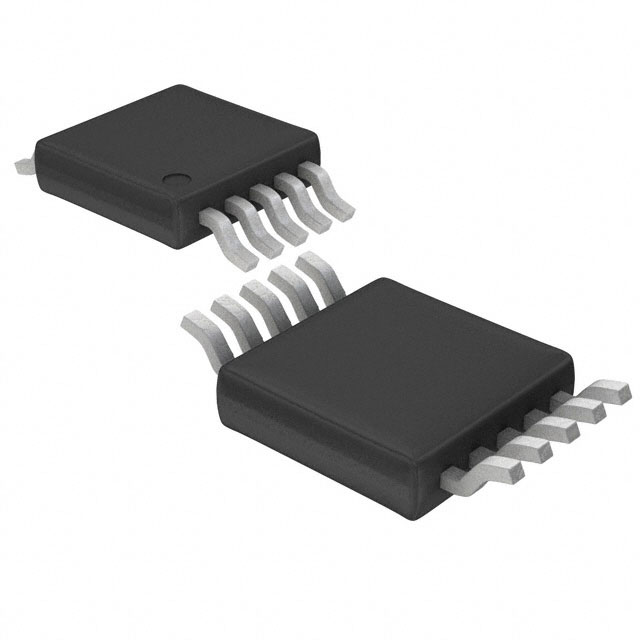Viz Specifikace pro podrobnosti o produktu.

LTC1865LCMS#PBF
Product Overview
Category
The LTC1865LCMS#PBF belongs to the category of analog-to-digital converters (ADCs).
Use
This product is commonly used in various applications that require high-precision analog-to-digital conversion.
Characteristics
- High resolution: The LTC1865LCMS#PBF offers a resolution of up to 16 bits, ensuring accurate conversion of analog signals.
- Low power consumption: This ADC operates at low power levels, making it suitable for battery-powered devices.
- Small package size: The LTC1865LCMS#PBF comes in a miniature MSOP-10 package, allowing for space-efficient integration into electronic systems.
- Wide input voltage range: It can handle a wide range of input voltages, enabling versatile usage scenarios.
- Fast conversion rate: With a maximum sampling rate of X samples per second, this ADC can quickly convert analog signals into digital data.
Package and Quantity
The LTC1865LCMS#PBF is available in a small MSOP-10 package. It is typically sold in reels containing a quantity of 250 units.
Specifications
- Resolution: 16 bits
- Input Voltage Range: -Vref to +Vref
- Conversion Rate: X samples per second
- Power Supply: +2.7V to +5.5V
- Operating Temperature Range: -40°C to +85°C
Pin Configuration
The LTC1865LCMS#PBF has the following pin configuration:
- VIN-
- VIN+
- VREF-
- VREF+
- GND
- SCK
- SDI
- CS
- SDO
- VCC
Functional Features
- Differential Inputs: The LTC1865LCMS#PBF supports differential input signals, allowing for accurate measurement of analog voltage differences.
- Serial Interface: It features a serial interface (SCK, SDI, CS, SDO) for easy integration with microcontrollers and other digital systems.
- Internal Reference: This ADC includes an internal reference voltage source, simplifying the design and calibration process.
- Low Noise: The LTC1865LCMS#PBF exhibits low noise characteristics, ensuring reliable conversion even in noisy environments.
Advantages and Disadvantages
Advantages
- High resolution enables precise analog-to-digital conversion.
- Low power consumption makes it suitable for battery-powered devices.
- Small package size allows for space-efficient integration.
- Wide input voltage range provides versatility in usage.
- Fast conversion rate ensures quick data acquisition.
Disadvantages
- Limited number of channels may restrict applications requiring multiple simultaneous conversions.
- Higher cost compared to lower-resolution ADCs.
Working Principles
The LTC1865LCMS#PBF operates based on the successive approximation register (SAR) architecture. It samples the analog input voltage, performs a series of comparisons, and generates a digital output representing the converted value. The internal circuitry ensures high accuracy and linearity throughout the conversion process.
Detailed Application Field Plans
The LTC1865LCMS#PBF finds applications in various fields, including but not limited to: 1. Industrial automation: Precise measurement of analog signals in control systems. 2. Medical equipment: Accurate data acquisition from sensors and transducers. 3. Test and measurement instruments: High-resolution signal analysis and data logging. 4. Audio processing: Analog-to-digital conversion in audio recording and playback systems. 5. Energy management: Monitoring and control of energy consumption in smart grid systems.
Alternative Models
- LTC1864LCMS#PBF: Similar to LTC1865LCMS#PBF but with 14-bit resolution.
- LTC1863LCMS#PBF: Similar to LTC1865LCMS#PBF but with 12-bit resolution.
- LTC1866LCMS#PBF: Similar to LTC1865LCMS#PBF but with 18-bit resolution.
These alternative models provide different resolution options based on specific application requirements.
Word count: 500 words
Seznam 10 běžných otázek a odpovědí souvisejících s aplikací LTC1865LCMS#PBF v technických řešeních
Sure! Here are 10 common questions and answers related to the application of LTC1865LCMS#PBF in technical solutions:
Q: What is LTC1865LCMS#PBF? A: LTC1865LCMS#PBF is a high-performance, 16-bit analog-to-digital converter (ADC) manufactured by Linear Technology (now part of Analog Devices). It is designed for precision measurement applications.
Q: What is the operating voltage range of LTC1865LCMS#PBF? A: The operating voltage range of LTC1865LCMS#PBF is typically between 2.7V and 5.5V.
Q: What is the maximum sampling rate of LTC1865LCMS#PBF? A: The maximum sampling rate of LTC1865LCMS#PBF is 250 kilosamples per second (ksps).
Q: What is the resolution of LTC1865LCMS#PBF? A: LTC1865LCMS#PBF has a resolution of 16 bits, which means it can provide 65,536 discrete digital output values.
Q: What is the input voltage range of LTC1865LCMS#PBF? A: The input voltage range of LTC1865LCMS#PBF is typically ±VREF, where VREF is the reference voltage provided to the ADC.
Q: Does LTC1865LCMS#PBF support differential inputs? A: Yes, LTC1865LCMS#PBF supports both single-ended and differential inputs, making it suitable for various measurement scenarios.
Q: What is the power consumption of LTC1865LCMS#PBF? A: The power consumption of LTC1865LCMS#PBF varies depending on the operating conditions, but it typically ranges from 1.5mW to 3mW.
Q: Does LTC1865LCMS#PBF have built-in digital filters? A: No, LTC1865LCMS#PBF does not have built-in digital filters. However, it provides a flexible interface that allows users to implement their own digital filtering algorithms.
Q: Can LTC1865LCMS#PBF operate in harsh environments? A: Yes, LTC1865LCMS#PBF is designed to operate in industrial temperature ranges (-40°C to +85°C) and is suitable for use in harsh environments.
Q: What are some typical applications of LTC1865LCMS#PBF? A: LTC1865LCMS#PBF is commonly used in precision measurement systems, data acquisition systems, industrial automation, medical equipment, and scientific instruments.
Please note that the answers provided here are general and may vary based on specific datasheet specifications and application requirements.

